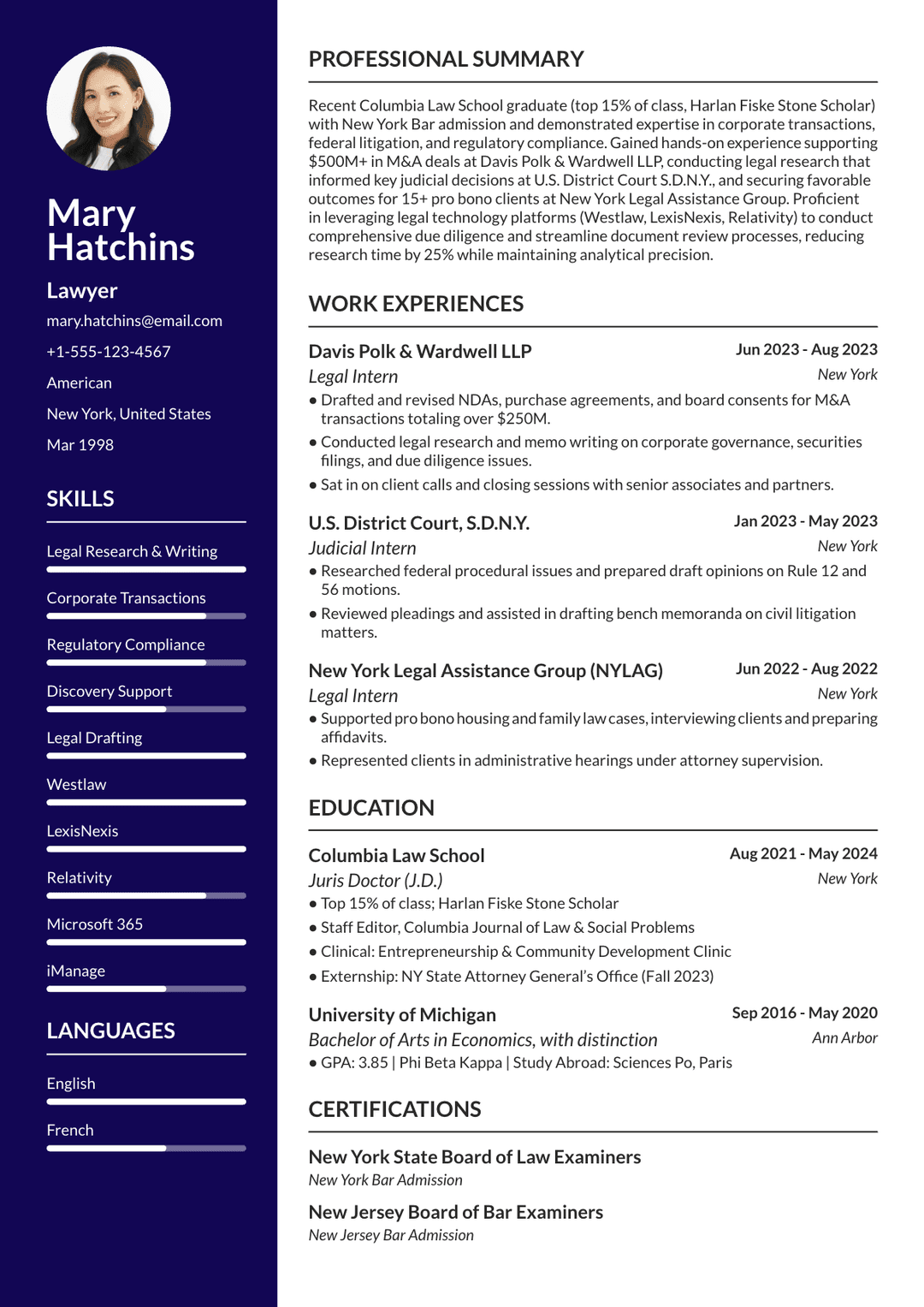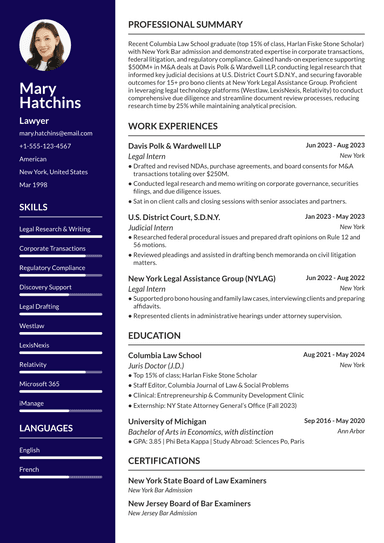Crafting an Impressive Lawyer Resume: Full Guide + Example
This complete guide with detailed explanations and expert tips will teach you how to write an acting resume in record time!
Edit this resume
Unlike resumes in other industries, legal resumes must meet specific formatting conventions while showcasing the unique combination of academic credentials, bar admissions, and practical experience that law firms expect.
The legal job market remains fiercely competitive, with law firms receiving hundreds of applications for every open position. Your lawyer resume isn't just a summary of your background; it's your first opportunity to demonstrate the attention to detail, precision, and professionalism that define successful legal careers.
This comprehensive guide will help you create a compelling lawyer resume that stands out and helps you land the role you’re aiming for. Read on!
- Legal resumes require specific formatting and content different from other industries, with emphasis on education credentials appearing prominently near the top.
- Bar admissions and licensing information must be clearly displayed, as these represent non-negotiable requirements for legal practice.
- Quantifiable achievements and case results are essential for demonstrating your impact—vague descriptions won't cut it in the legal field.
- ATS optimization has become important as more law firms adopt applicant tracking systems to manage their hiring processes.
What Makes a Lawyer Resume Different?
Lawyer resumes are different from standard business resumes, as they reflect the profession's emphasis on credentials, precision, and conservative presentation.
The legal industry places exceptional weight on educational pedigree, making law school rankings, class standings, and academic honors far more relevant than in other fields. Bar admissions aren't just preferred qualifications, but also licensing requirements that must be prominently displayed with specific jurisdiction and date information.
Furthermore, the content expectations also differ significantly. Legal employers expect to see detailed information about case types, court systems, regulatory knowledge, and specific areas of law rather than generic business achievements.
Therefore, your experience descriptions should demonstrate familiarity with legal procedures, document preparation, client counseling, and litigation processes.
Meanwhile, formatting standards in law remain notably conservative. While other industries have embraced creative designs and infographics, legal resumes should maintain traditional, clean layouts that prioritize readability and professional appearance.
Outstanding Lawyer Resume Example
Let’s see what a great lawyer resume example looks like:
Essential Components of a Lawyer Resume
Now that we’ve reviewed the example, let’s break down the main sections of a lawyer resume.
#1. Contact Information and Resume Summary
Your resume header should include your full name, bar admission information (if applicable), phone number, professional email address, and LinkedIn profile URL. Some attorneys include their office address, though this isn't always necessary for confidentiality reasons.
The resume summary (typically 2-3 sentences) should immediately establish your legal expertise, years of experience, and primary practice areas.
Effective legal summaries avoid generic phrases and instead focus on specific legal accomplishments, notable case outcomes, or specialized expertise. Consider mentioning particular types of clients, transaction values, or regulatory environments where you've worked to provide concrete context for your experience level.
Here’s an example:
Strategic and results-oriented attorney with 8+ years of experience in corporate and commercial law, successfully closing over $200M in M&A transactions and reducing client liability exposure by 45% through proactive risk assessment strategies. Adept at navigating complex regulatory environments, leading cross-functional legal teams, and negotiating high-stakes contracts with Fortune 500 clients. Recognized for streamlining compliance processes that cut review time by 30% without compromising legal rigor.
#2. Education Section
Legal education information deserves prominent placement, typically appearing before or immediately after your professional experience section. Include your law school name, degree, graduation year, and any honors such as magna cum laude, law review participation, or order of the coif.
Class rank can be included if it strengthens your candidacy; for example, if you graduated in the top third of your class.
Don't overlook relevant coursework, especially if you're targeting specialized practice areas. Clinical programs, externships, and moot court experience demonstrate practical legal training beyond classroom learning. Your undergraduate education should also be included, particularly if it's relevant to your legal practice area or from a prestigious institution.
Study abroad programs, joint degree programs (JD/MBA, JD/LLM), or specialized certificates can differentiate your candidacy. However, maintain focus on achievements most relevant to your target positions rather than creating exhaustive academic inventories.
Let’s see a nice example of this section:
EDUCATION
Harvard Law School, J.D.
2017
- Magna cum laude
- Top 10% of class; Dean’s Scholar Prize (Contracts, Constitutional Law)
- Articles Editor, Harvard Law Review
- Clinical: International Human Rights Clinic
- Moot Court Finalist; Externship with U.S. District Court (D. Mass.)
B.A. in Political Science
University of California, Berkeley
2013
- Summa cum laude
- GPA: 3.95; Phi Beta Kappa
- Senior Thesis: Constitutional Limits in National Security Law
#3. Bar Admissions and Licenses
This section requires precise formatting that clearly communicates your licensing status to potential employers. List each jurisdiction where you're admitted to practice, followed by the admission date. Use the format: "New York (2020), California (2021)" or separate lines for multiple admissions.
Additionally, if you're awaiting bar results, note "Admission pending" with the expected date.
Some attorney resumes also include federal court admissions, specialized certifications, or other professional licenses relevant to their practice. Patent attorneys, for example, should prominently display their USPTO registration number and admission date.
An example of this section looks like this:
BAR ADMISSIONS & LICENSES
- California (2021)
- New York (2020)
- U.S. District Court for the Southern District of New York (2022)
- U.S. Court of Appeals for the Ninth Circuit (2023)
- District of Columbia — Admission Pending (Expected October 2025)
#4. Legal Experience
You should structure your legal work experience to highlight progressively responsible roles within law firms, corporate legal departments, government agencies, or judicial chambers.
Each position should clearly indicate your level of responsibility, types of cases handled, and measurable outcomes achieved. The legal profession values specificity, so make sure you replace vague terms like "assisted with" with precise descriptions of your role in case development, legal research, brief writing, or client management.
Moreover, focus on case types and areas of law relevant to your target positions. If you're applying for corporate positions, emphasize transaction experience, regulatory knowledge, and business advisory work rather than litigation experience. Conversely, litigation positions require detailed descriptions of court appearances, motion practice, discovery management, and trial experience.
Client representation experience deserves specific attention. Describe the types of clients you've served—Fortune 500 companies, small businesses, individuals, non-profits—and the scope of your responsibility.
Here’s a good example:
WORK EXPERIENCE
Senior Associate – Corporate LawLatham & Watkins LLP, New York, NY
2021 – Present
- Lead counsel on over 30 M&A transactions, collectively valued at $1.2B, advising multinational clients on deal structure, due diligence, and regulatory compliance.
- Negotiated and drafted complex commercial contracts, including joint venture agreements, vendor deals, and SaaS licenses for Fortune 500 clients.
- Developed internal compliance frameworks for clients navigating SEC, GDPR, and CCPA regulations, reducing regulatory risk exposure by up to 40%.
- Supervised a team of junior associates and paralegals, overseeing drafting and review of closing documents, filings, and opinion letters.
Associate – Corporate TransactionsPaul Hastings LLP, Los Angeles, CA
2018 – 2021
- Represented emerging tech companies and private equity firms in Series A–D financings, totaling over $400M in funding rounds.
- Conducted due diligence for acquisitions in healthcare, fintech, and SaaS sectors; identified key risk factors and proposed restructuring strategies.
- Advised clients on Delaware corporate governance, board obligations, and fiduciary duties during high-stakes shareholder disputes.
#4. Legal Skills Section
Technical skills in law encompass both legal knowledge and technology proficiency.
Legal research platforms like Westlaw, LexisNexis, and Bloomberg Law are standard expectations, but specialized databases for your practice area may be worth mentioning. Additionally, document management systems, e-discovery platforms, and case management software demonstrate technological competency.
Language abilities can be particularly valuable for international law firms or practices serving diverse client populations, and professional proficiency should be clearly distinguished from conversational ability. Specialized legal knowledge—such as familiarity with specific regulatory frameworks, international treaties, or niche practice areas—can also differentiate your candidacy.
Also, don't overlook resume skills that complement legal expertise. Financial analysis, project management, or industry-specific knowledge (healthcare, technology, energy) can be highly valuable for certain positions. However, maintain focus on skills directly relevant to your target roles rather than creating comprehensive skill inventories.
This is what such a section on your resume should look like:
SKILLS
Legal Expertise:
- Corporate Law
- Contract Drafting & Negotiation
- Regulatory Compliance (SEC, GDPR, CCPA)
- Legal Risk Assessment
- Legal Research & Writing
Litigation & Dispute Resolution:
- Pretrial Motion Practice
- Discovery Management
- Deposition Preparation
- Trial Strategy
Client & Case Management:
- Fortune 500 Representation
- Cross-Border Transactions
- Outside Counsel Coordination
- Legal Due Diligence
- Client Advisory Services
Technical Proficiencies:
- Westlaw
- LexisNexis
- Relativity
- iManage
- Microsoft 365
- DocuSign
- Contract Express
Languages:
- English (native)
- Spanish (professional proficiency)
#5. Additional Sections
If there’s enough space on your resume, you can also add:
- Publications. They demonstrate thought leadership and writing ability that law firms value highly. Include law review articles, legal periodicals, blog posts, or speaking engagements with full citations. Professional associations show engagement with the legal community and commitment to ongoing professional development.
- Volunteer work and pro bono service. These demonstrate commitment to justice and provide valuable experience. Detail the types of cases or causes you've supported and any notable outcomes achieved. This information can be particularly valuable for firms with strong pro bono programs or a public interest focus.
3 Common Mistakes to Avoid When Creating Your Lawyer Resume
Before you start writing a lawyer resume, you should make sure to avoid the following types of mistakes:
Typography inconsistencies immediately signal a lack of attention to detail, which is a critical flaw for legal professionals. Use consistent resume fonts (typically Times New Roman or Arial in 11-12 point), uniform spacing, and standard margins throughout your document.
Avoid creative formatting, graphics, or unusual layouts that can confuse ATS systems or appear unprofessional to conservative legal employers.
Furthermore, length considerations depend on your experience level, but one page is typically insufficient for experienced attorneys, while three pages may be excessive. Most legal resumes should be 2-3 pages with substantive content rather than filler. Ensure your most important information appears on the first page to capture initial attention.
Some common layout mistakes include cramped margins, inconsistent alignment, or poor section organization. Your resume should guide readers logically through your qualifications with clear section headings and appropriate white space. Print a test copy to verify that formatting appears clean and professional on paper.
Vague descriptions fail to demonstrate the specific competencies that legal employers seek. Replace generic phrases like "provided legal advice" with precise descriptions: "advised healthcare clients on HIPAA compliance, preventing potential $2.3M in regulatory penalties through proactive privacy program implementation." Quantifiable results provide concrete evidence of your capabilities and impact.
Additionally, irrelevant information dilutes your legal qualifications and wastes precious resume space. Focus on experience, education, and achievements directly related to legal practice rather than unrelated work history or hobbies. However, don't completely ignore pre-law experience if it demonstrates transferable skills or relevant industry knowledge.
Missing context makes it difficult for employers to assess your qualifications. Specify your level of responsibility, supervision received, and scope of authority in each role. For example, "Managed discovery process for class action litigation involving 50,000+ documents" provides much clearer information than "handled discovery matters."
Improper bar admission formatting can create confusion about your licensing status. Therefore, you should use standard formatting with jurisdiction names and admission dates clearly displayed. Verify the accuracy of all dates and jurisdictions, as these can be easily verified and errors damage your credibility immediately.
Besides this, missing education details represent missed opportunities to demonstrate your qualifications. Include relevant academic achievements, specialized coursework, or clinical experience that supports your practice area focus. Legal employers place significant weight on educational credentials, so present them strategically and completely.
Finally, inadequate emphasis on legal writing skills overlooks a core competency that all legal positions require. Therefore, you should mention specific examples of briefs filed, contracts drafted, or other legal documents prepared. Mention any writing recognition, publication experience, or communications that demonstrate your analytical and writing abilities.
3 Extra ATS Optimization Tips for Legal Resumes
Applicant tracking systems have become increasingly common in law firm hiring, requiring strategic keyword integration and compatible formatting. Here’s how you can achieve it:
- Research target positions carefully to identify essential qualifications, practice areas, and skills that should appear throughout your resume. Include both abbreviations and full terms—"M&A" and "mergers and acquisitions"—to maximize keyword matching.
- Consider legal-specific keywords, which include practice areas (corporate law, litigation, intellectual property), legal processes (due diligence, discovery, appellate practice), and technology skills (Westlaw, LexisNexis, contract management systems). However, avoid keyword stuffing that makes your resume difficult to read, as human reviewers will ultimately evaluate your candidacy.
- Use standard section headings, avoiding graphics or tables, and maintaining consistent typography. Save your resume in both PDF and Word formats, as different systems may have varying compatibility requirements. Test your resume by submitting it through online application systems to verify proper parsing.
Create a Job-Winning Lawyer Resume With Our Tool
ResumeBuilder.so offers specialized templates designed specifically for legal professionals, incorporating industry-standard formatting and ATS optimization features. Our platform includes legal-specific content suggestions, formatting guidance, and real-time optimization recommendations that help you create compelling lawyer resumes efficiently.
Legal resume templates available through our platform are regularly updated to reflect current hiring trends and ATS requirements. These templates incorporate feedback from legal recruiters and hiring managers to ensure maximum effectiveness in the competitive market.
Final Thoughts
Creating an effective lawyer resume requires balancing traditional legal profession expectations with modern hiring technology and market demands. Therefore, to achieve this, it’s best to focus on demonstrating specific legal competencies, quantifiable achievements, and professional growth that differentiate you from other qualified attorneys.
Your resume represents your professional brand and attention to detail, and these are qualities that are essential for legal practice success. Invest the time necessary to craft a compelling document that accurately reflects your qualifications and positions you competitively for your target opportunities.
Lawyer Resume FAQ
#1. What format should a lawyer resume be?
Lawyers should use a traditional reverse-chronological format with a clean, professional design that emphasizes education credentials and legal experience. Avoid creative layouts as the legal industry values conservative presentation and ATS compatibility.
#2. How long should a lawyer resume be?
A lawyer resume should be one to two pages long, while experienced attorneys may extend to three pages for comprehensive career documentation. You should focus on relevant legal experience and substantive achievements rather than padding with unnecessary details.
#3. Should I include my GPA on a lawyer resume?
You should include your GPA on a lawyer resume if it's 3.5 or higher, or if you're a recent graduate applying for competitive positions. Undergraduate GPA is typically omitted unless it's exceptionally high or relevant to your practice area specialization.
#4. What skills should lawyers highlight on resumes?
Lawyers should highlight their legal research capabilities, brief writing experience, client counseling skills, litigation experience, and regulatory knowledge specific to their practice areas. They can also include relevant technology proficiency, like LexisNexis, Westlaw, and document management systems used in legal practice.
#5. How do I show career progression as a lawyer?
You can show career progression as a lawyer through increasing case complexity, expanded client responsibilities, leadership roles, and progression from associate to senior associate or counsel positions. It’s also recommended to include specific metrics about practice growth, team management, or business development achievements.
#6. Should I include pro bono work on my lawyer resume?
Yes, you should include pro bono work on your lawyer resume, as it demonstrates commitment to justice and provides valuable practical experience that many law firms value. You can mention specific case types handled, outcomes achieved, and skills developed through volunteer legal service in your experience section.


